Find the total number of amphoteric compound from following BeO,Be(OH)2,BaO,Sr(OH)2
The correct Answer is:2
To determine the total number of amphoteric compounds among the given substances (BeO, Be(OH)₂, BaO, Sr(OH)₂), we need to analyze each compound based on the definition of amphoteric compounds.
1. Understanding Amphoteric Compounds:
Amphoteric compounds are those that can act as both acids and bases. This means they can react with both acids and bases.
2. Analyzing Each Compound:
- BeO (Beryllium Oxide):
- Beryllium oxide is known to exhibit amphoteric behavior. It can react with acids to form beryllium salts and with bases to form beryllates.
- Reactions:
- With acid: BeO + 2HCl → BeCl₂ + H₂O
- With base: BeO + 2NaOH + 2H₂O → Na₂Be(OH)₄
- Conclusion: BeO is amphoteric.
- Be(OH)₂ (Beryllium Hydroxide):
- Beryllium hydroxide is also amphoteric. It reacts with acids to form beryllium salts and with strong bases to form beryllates.
- Reactions:
- With acid: Be(OH)₂ + 2HCl → BeCl₂ + 2H₂O
- With base: Be(OH)₂ + 2NaOH → Na₂Be(OH)₄
- Conclusion: Be(OH)₂ is amphoteric.
- BaO (Barium Oxide):
- Barium oxide is a basic oxide. It does not exhibit amphoteric behavior as it reacts only with acids.
- Reactions:
- With acid: BaO + 2HCl → BaCl₂ + H₂O
- Conclusion: BaO is not amphoteric.
- Sr(OH)₂ (Strontium Hydroxide):
- Strontium hydroxide is a strong base and does not exhibit amphoteric behavior. It reacts only with acids.
- Reactions:
- With acid: Sr(OH)₂ + 2HCl → SrCl₂ + 2H₂O
- Conclusion: Sr(OH)₂ is not amphoteric.
3. Counting the Amphoteric Compounds:
- From the analysis above, we found that:
- BeO is amphoteric.
- Be(OH)₂ is amphoteric.
- BaO is not amphoteric.
- Sr(OH)₂ is not amphoteric.
- Therefore, the total number of amphoteric compounds is 2 (BeO and Be(OH)₂).
Final Answer:
The total number of amphoteric compounds from the given list is 2.
Amphoteric compounds are those that can act as both acids and bases. This means they can react with both acids and bases.
- BeO (Beryllium Oxide):
- Beryllium oxide is known to exhibit amphoteric behavior. It can react with acids to form beryllium salts and with bases to form beryllates.
- Reactions:
- With acid: BeO + 2HCl → BeCl₂ + H₂O
- With base: BeO + 2NaOH + 2H₂O → Na₂Be(OH)₄
- Conclusion: BeO is amphoteric.
- Beryllium hydroxide is also amphoteric. It reacts with acids to form beryllium salts and with strong bases to form beryllates.
- Reactions:
- With acid: Be(OH)₂ + 2HCl → BeCl₂ + 2H₂O
- With base: Be(OH)₂ + 2NaOH → Na₂Be(OH)₄
- Conclusion: Be(OH)₂ is amphoteric.
- Barium oxide is a basic oxide. It does not exhibit amphoteric behavior as it reacts only with acids.
- Reactions:
- With acid: BaO + 2HCl → BaCl₂ + H₂O
- Conclusion: BaO is not amphoteric.
- Strontium hydroxide is a strong base and does not exhibit amphoteric behavior. It reacts only with acids.
- Reactions:
- With acid: Sr(OH)₂ + 2HCl → SrCl₂ + 2H₂O
- Conclusion: Sr(OH)₂ is not amphoteric.
- From the analysis above, we found that:
- BeO is amphoteric.
- Be(OH)₂ is amphoteric.
- BaO is not amphoteric.
- Sr(OH)₂ is not amphoteric.
- Therefore, the total number of amphoteric compounds is 2 (BeO and Be(OH)₂).
The total number of amphoteric compounds from the given list is 2.
Topper's Solved these Questions
- BOOK - JEE MAINS PREVIOUS YEARCHAPTER - JEE MAIN 2021EXERCISE - SECTION-A100videos
JEE MAIN 2021
- BOOK - JEE MAINS PREVIOUS YEARCHAPTER - JEE MAIN 2021EXERCISE - SECTION-B50videos
JEE MAIN 2021
- BOOK - JEE MAINS PREVIOUS YEARCHAPTER - JEE MAINEXERCISE - CHEMISTRY150videos
JEE MAIN
- BOOK - JEE MAINS PREVIOUS YEARCHAPTER - JEE MAIN 2022EXERCISE - Question561videos
JEE MAIN 2022
Similar Questions
Knowledge Check
- Question 1 - Select One
Amphoterism
Amphoteric oxides, such as aluminium oxide, are soluble both in strongly acidic and in strongly base solutions :
In acid:Al2O3(s)+6H3O+(aq)⇔2Al3+(aq)+9H2O(l)
In base:Al(OH)3(s)+OH−(aq)⇔Al(OH)−4(aq)
Dissolution of Al(OH)3 in excess base is just a special case of the effect of complex-ion formation on solubility.Al(OH)3 dissolves because excess OH− ions convert it to the soluble complex ion Al(OH)−4(aluminate ion)The effect of pH on the solubility of Al(OH)3 is shown in figure.
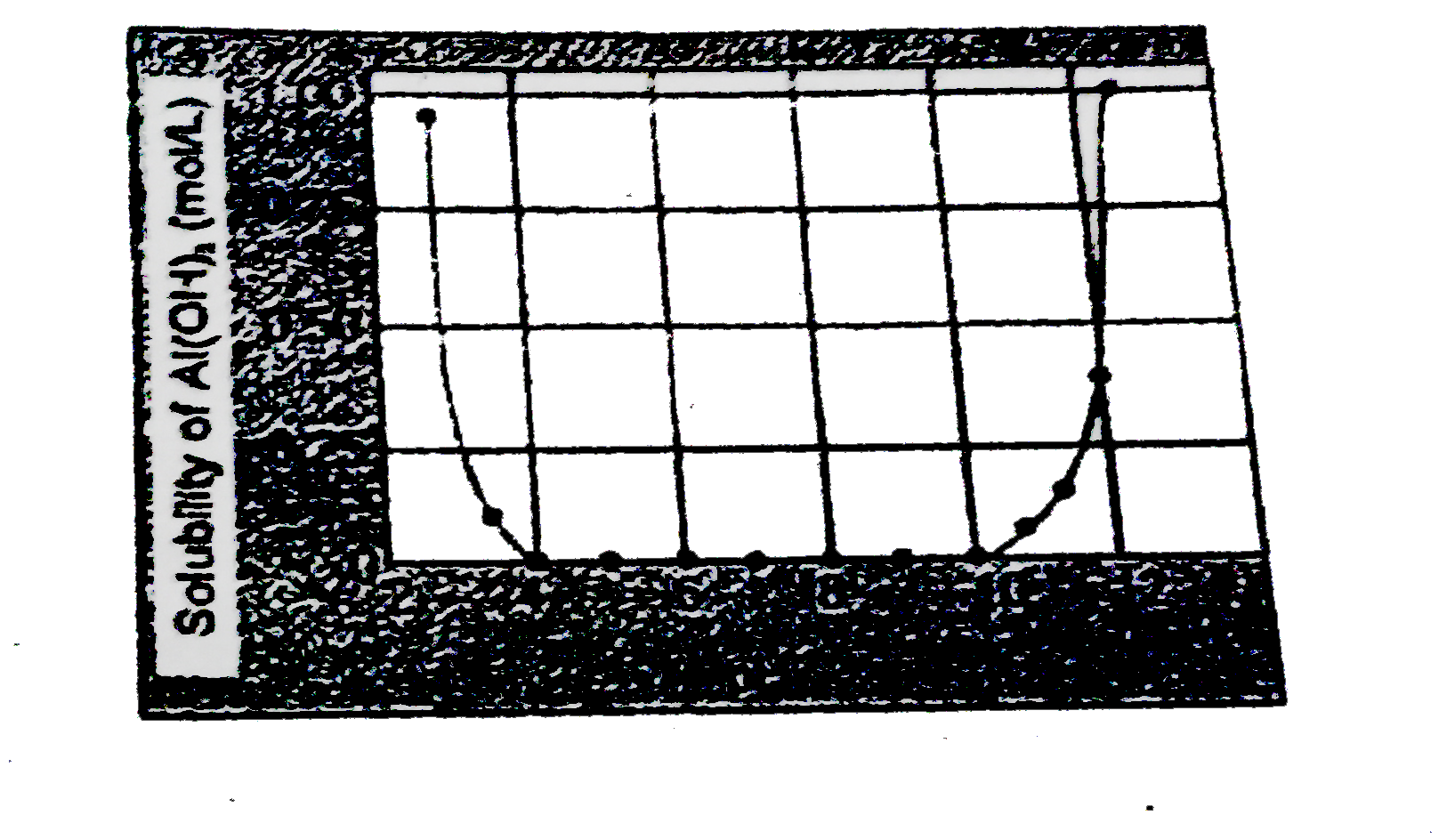
Other examples of amphoteric hydroxides include Zn(OH)2,Cr(OH)3,Sn(OH)2andPb(OH)2, which react with excess OH− ions to form the soluble complex ion Zn(OH)2−4(zincate ion),Cr(OH)−4(chromite ion),Sn(OH)−3 , Fe(OH)2andFe(OH)3 , dissolve in strong acid but not in strong base.
Which of the following curves best represents the variation of solubility of ferrous hydroxide Fe(OH)2 with the concentration of [H+] ions in the solution:A B
B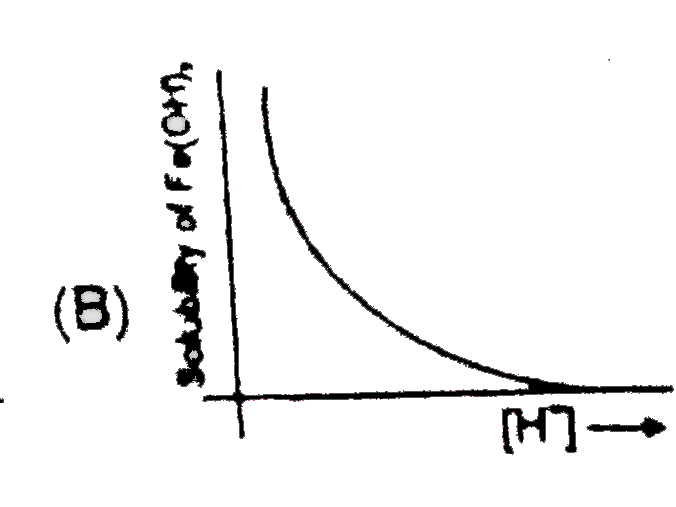 C
C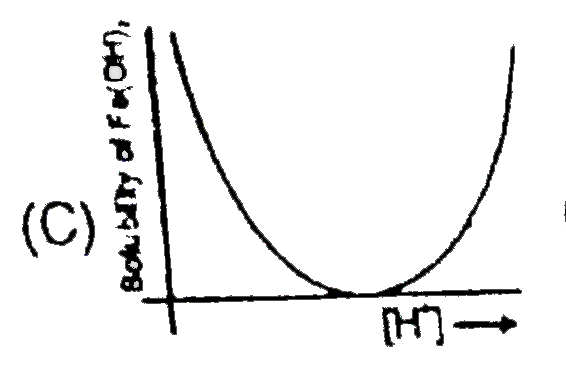 D
D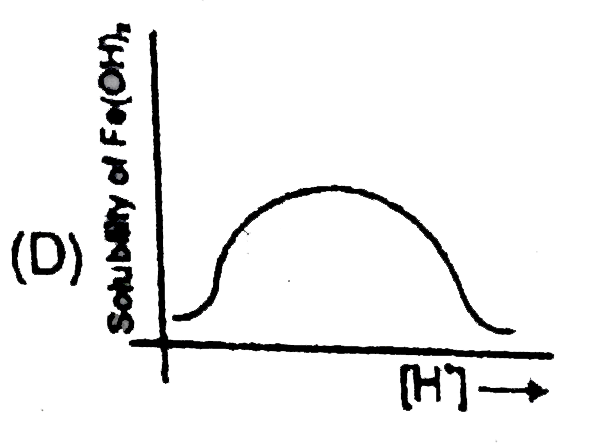
- Question 2 - Select One
Amphoterism
Amphoteric oxides, such as aluminium oxide, are soluble both in strongly acidic and in strongly base solutions :
In acid:Al2O3(s)+6H3O+(aq)⇔2Al3+(aq)+9H2O(l)
In base:Al(OH)3(s)+OH−(aq)⇔Al(OH)−4(aq)
Dissolution of Al(OH)3 in excess base is just a special case of the effect of complex-ion formation on solubility.Al(OH)3 dissolves because excess OH− ions convert it to the soluble complex ion Al(OH)−4(aluminate ion)The effect of pH on the solubility of Al(OH)3 is shown in figure.
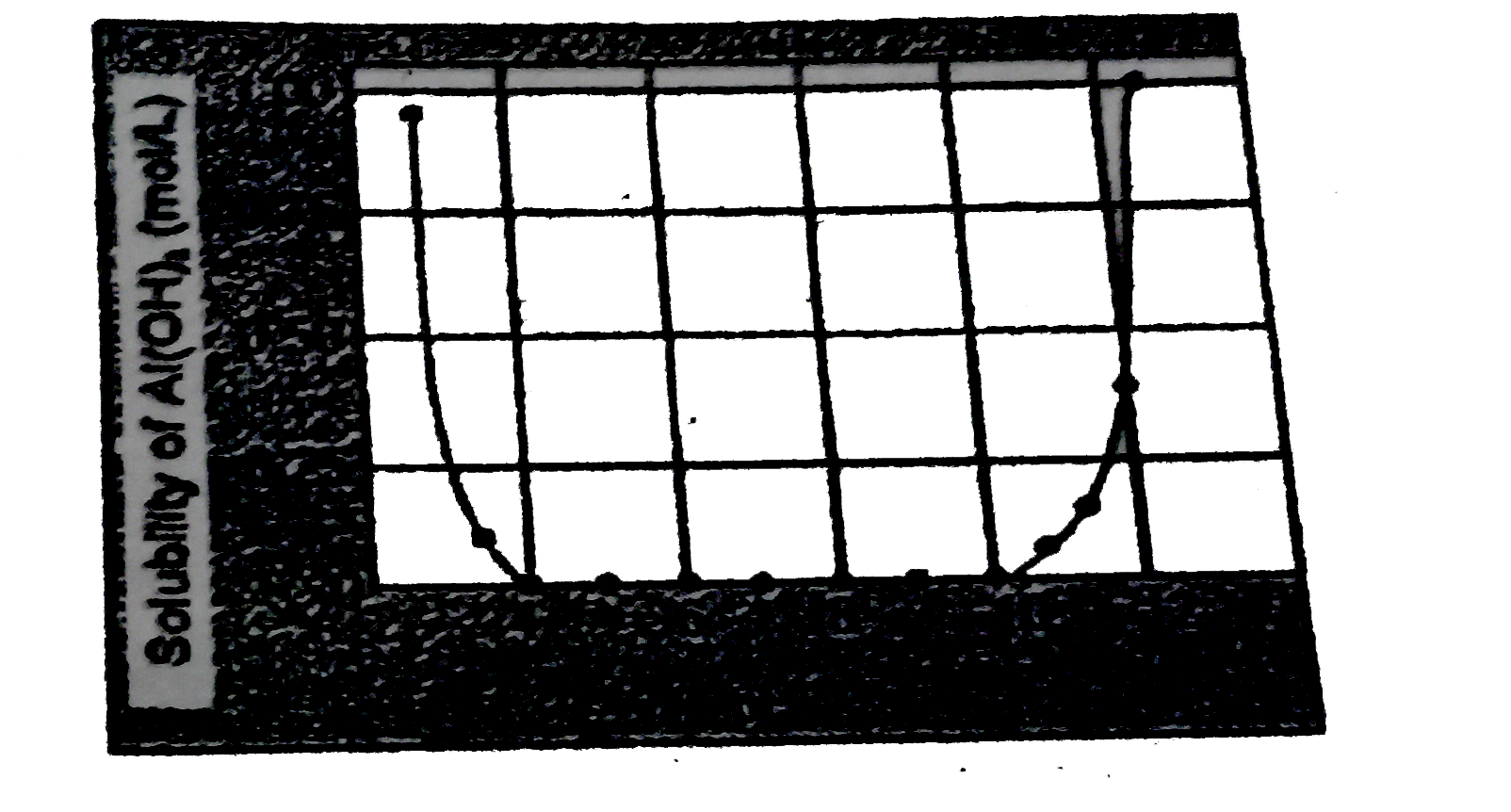
Other examples of amphoteric hydroxides include Zn(OH)2,Cr(OH)3,Sn(OH)2andPb(OH)2, which react with excess OH− ions to form the soluble complex ion Zn(OH)2−4(zincate ion),Cr(OH)−4(chromite ion),Sn(OH)−3 , Fe(OH)2andFe(OH)3 , dissolve in strong acid but not in strong base.
Zn(OH)2 is a amphoteric hydroxide and is involved in the following two equilbria in aqueous solutions
Zn(OH)2(s)⇔Zn2+(aq)+2OH−(aq),Ksp=1.2×10−17
Zn(OH)2(s)+2OH−(aq)⇔[Zn(OH)4]2−(aq),K∘=0.12
At what pH the solubility of Zn(OH)2 be minimum ?A4B10C6D8
Amongst the following, the following , the total number of amphoteric oxides is CO,SnO,PbO,CO2,SiO2,GeO2,SnO2,PbO2
View SolutionTotal number of element(s) which have only single oxidation state (other than zero) in their corresponding stable compounds: Cs, Ba, F, Zn,Be,Al, Sr,Ga, Pb.
View SolutionFind the oxidation number of carbon in the following compounds: CH3OH,CH2O,HCOOH,C2H2.
View SolutionWhen the following aldohexose exists in its D-configuration, the total number of stereoisomers in its pyranose form is.
OHC−CH2−CH| OH−CH| OH−CH| OH−CH2−OHView SolutionFind the number of compounds from the following in which the element in the anionic part is in the minimum oxiadation state of it :
LiH,Mg3Bi2,Al4C3,Ca3P2,BaO2View SolutionAmongst the following, the total number of compounds soluble in concentrated NH3 solution is:
(A)Ag2CrO4, (B)Cu(OH)2.CuSO4, (C )PbSO3 , (D)Al(OH)3 , (E)NI(OH)2
(F)Zn3(PO4)2, (G)BaSO4, (H)Bi(OH)2NO3 , (I)Mn(OH)2View Solution

